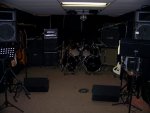Should bass traps have an open back?
Here's my situation - I made (12) panels for my basement band practice / recording space.
The panels are 2" x 24" x 48" OC 703 mounted to 1/4" particle board, wrapped and stapled
(no wood on the sides - cloth is basically holding the fiberglass to the wood.) The basement
is 23' x 19' x 8' tall with carpet, drop-ceiling, and paneling. I was trying to tame the reverberation
and "brightness" but with these panels the bass problem became accentuated - the room became
very boomy and dark. My plan was to re-do these and make them 4" thick (doubling the OC703)
and mounting them across the corners behind the band and along the ceiling corners. My hope is
that this will help tame the bass and liven up the room. Should I make these to have an "open back"
or is the 1/4" particle board thin enough that it really won't make much of a difference either way.
Here is a pic of the space.

Thanks for your input.
Here's my situation - I made (12) panels for my basement band practice / recording space.
The panels are 2" x 24" x 48" OC 703 mounted to 1/4" particle board, wrapped and stapled
(no wood on the sides - cloth is basically holding the fiberglass to the wood.) The basement
is 23' x 19' x 8' tall with carpet, drop-ceiling, and paneling. I was trying to tame the reverberation
and "brightness" but with these panels the bass problem became accentuated - the room became
very boomy and dark. My plan was to re-do these and make them 4" thick (doubling the OC703)
and mounting them across the corners behind the band and along the ceiling corners. My hope is
that this will help tame the bass and liven up the room. Should I make these to have an "open back"
or is the 1/4" particle board thin enough that it really won't make much of a difference either way.
Here is a pic of the space.

Thanks for your input.

